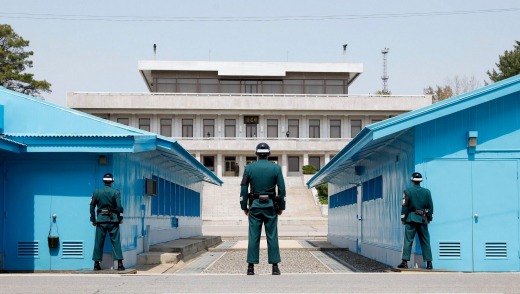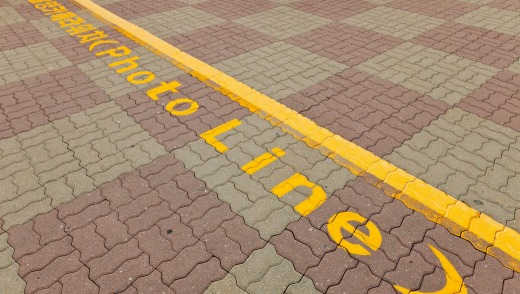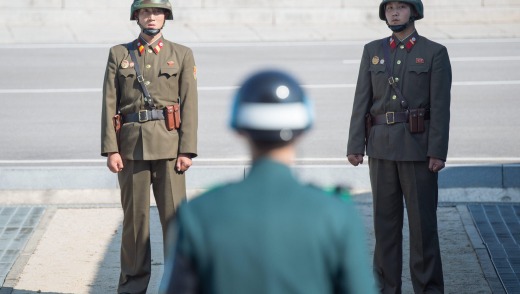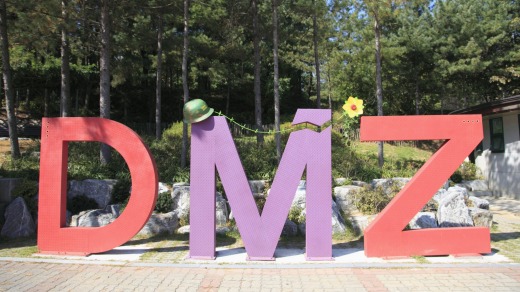The Korean demilitarised zone is an eerie tourist attraction, as Kelsey Munro discovers.
I imagined something else. Parallel lines of razor wire, a strip of no-man's land in the middle, armed guards on watchtowers, perhaps. But the famous, mysterious border between the two Koreas is stranger than that.
I did not expect a fun park, for example. Just before the main checkpoint to enter the demilitarised zone from the south, coloured steel girders lined with gaudy light bulbs rise above the treeline.
It's called Peace Land, and has a pirate ship ride and excited gaggles of school kids on excursion. At the upmarket mini-mall next door, there's a Popeyes fried chicken joint, a bagel takeaway, and a French bistro. There is a gift shop selling mini his-n-hers fatigues and DMZ caps. Climb four storeys to a viewing platform and drop coins into fixed binoculars to peer across the river into the edge of the North. Here: a strange capitalist carnival of franchise chicken and takeaway frappuccinos; there: midnight disappearances and a nuclear-armed failed Stalinist utopia. DMZ tourism is a weird beast.

The armistice that put an end to the Korean War in 1953 split the peninsula into North and South Korea, and there the 238 kilometre long, four kilometre wide border has divided the Korean people ever since. Six decades after more than 3 million died in the conflict, it's among the world's most heavily armed borders, which is perhaps not surprising given the war never technically ended, and the North Korean leadership has demonstrated itself to be right up there with the world's most paranoid and brutal regimes. At the heart of the DMZ, soldiers from the North and South eyeball each other through mirrored aviators over the concrete span of Panmunjom. It's silent, and hardly anything moves. The soldiers stand immobile in a taekwondo pose, dressed in chunky black boots with white laces, wide leg pants that crop inches above the ankle, mirror aviators, black salad-bowl helmets. They look like an army dressed by the Village People, about to break into some kind of awesome synchronised dance.
Sadly, this does not actually happen.
There is a controlled tourism operation at the DMZ with a handful of tour companies working out of Seoul, a bit more than an hour's drive away. The Korean Tourism Office doesn't keep stats on the DMZ, but said 1.2 million foreign tourists visited the country in June 2014. Some nationalities can't get access at all, while Chinese and South Korean citizens are subject to extra restrictions. (Relatives seeking to pay respect to their relatives in the North must make do with a memorial in the carpark near Popeyes.) Within the demilitarised zone, approved tourists can visit Panmunjom, the US-Korea joint security area, and sometimes the tunnels, discovered in the 1970s and assumed to be part of a cunning North Korean plan for a stealth attack.

So here we are, waiting in a bus at the bridge checkpoint on a brilliantly sunny day, while some unpromising sounding negotiations go on between soldiers around us. Hundreds of troops from both sides have died in outbreaks of violence since the armistice. The day we visit is only two weeks since two South Korean soldiers were maimed by landmines about eight kilometres from here, sparking the biggest flare-up of inter-Korean tensions in a few years. Now everybody has suddenly got very serious. Not at all like at Peace Land.
After an hour's wait, the soldiers finally wave us through, and we roll past spiked metal drums over the bridge and into the tip of the north. We drive for several minutes through verdant fields and farmland. It's quite beautiful: the restrictions on access have inadvertently turned the DMZ into a sort of ecological park where some of Asia's most endangered birds and animals have found sanctuary. Red-crowned cranes, mountain gorals, musk deer have been sighted. There's even rumours of a Siberian tiger in the forest.
In a carpark at the Joint Command headquarters known as Camp Bonifas, a young Korean corporal climbs on our minibus. Aviators, chains off the epaulets, mid-west accented English. Kind of bossy. He has a lot of rules: no notebooks out of the bus, no photos unless he says. No pictures or "gestures" from inside the bus.

I ask him why. Because, he explains, the North Korean soldiers can misinterpret gestures that tourists might make: they may claim provocation. The consequences are left to our imaginations, but it's worth knowing that in 2008 a South Korean tourist was shot dead by North Korean soldiers when she wandered off in another DMZ border area where tourists were then permitted. (They are not, anymore.)
We sit down in the museum at Camp Bonifas for a compulsory two-minute film history of the DMZ set to stirring martial music. There seems, in the scheme of things, heavy emphasis on a 1976 incident where North Korean soldiers left their post chopping trees to murder two American soldiers with their axes. Lights up. Out of the seats. Back in the bus.
We leave the joint command area and drive through the DMZ to Panmunjom, the "truce village" where the two armies spend a lot of time standing around staring at each other. It is eerie and still.

Corporal North leads us off the minibus into a modern, white concrete building with a grand staircase, empty of furniture. At the top of the staircase, there it is: the low blue UN-built conference rooms, and behind them, North Korea. A single North Korean soldier stands immobile, looking down at half a dozen South Korean soldiers who stare back towards him, and the row of foreigners behind them.
We are allowed, briefly, inside the main meeting room, where two South Korean soldiers watch over an empty polished table. It's small and unimposing, about the size of a modest classroom. Borders are mind-bending places, when you get down to it: an imaginary line that exists only by mutual agreement. In Panmunjom, the border runs through the middle of the conference room, right through the middle of the table where the North and South Koreans sit down for talks. "That side of the table is in North Korea," Corporal North says, pointing towards me. A ripple of excitement runs around our side of the table. Wow, I think, tapping my boot on a North Korean lino tile. We all raise our phones to take pictures. Corporal North calls time. Back in the bus.
Incredibly, within the DMZ there are two villages, one on the north side and one on the south. If you are wondering how the South Korean government gets people to live in Daeseong-dong, a village inside the DMZ, where there is a curfew and they have to farm under guard, I was too. The answer is: tax breaks and national service exemption. (But still, right?) Residents can come and go across the checkpoint to the south to interact with the rest of the country. But then they come home to sleep in the DMZ.

Then we roll up to a checkpoint on high ground that looks out over the site of the Infamous Axe Murder Incident and, further, to the North Korean DMZ village of Gijeong-dong. It is a cluster of low, small buildings surrounded by farm land, with a ludicrously high flag pole in the centre, and it's not clear if it's really inhabited or just for show. Corporal North gives us five minutes. I chat to the South Korean liaison who works for the joint command. She is very tall, and wears Harry Potter glasses. "This is a very strange place," I say to her, and she nods seriously. "Haunted, I think."
She's right. The division of the two Koreas is one of the saddest relics of the Cold War, and nothing looks like changing any time soon. In the closed, secretive North, existence is precarious and difficult. A major UN report authored by former Australian High Court judge Michael Kirby last year reported shocking brutality and crimes against humanity in the North, where only the regime and top military are said to live well. But in the South, wealthy after an extraordinary post-war boom, younger generations have grown detached from the idea of reunification.
Even at the DMZ, you exit through the gift shop. Back at Camp Bonifas, there's one doing a brisk trade with Japanese tourists (caps, jewellery, weird Korean candies, more kids' fatigues). And there is a free photobooth where you can put yourself in a superimposed frame with South Korean troops. I stand in front of the lens to get my pic, not quite sure whether to smile or frown.
MORE INFORMATION
visitkorea.or.kr
english.visitkorea.or.kr/enu/SI/SI_EN_3_4_1.jsp
GETTING THERE
Qantas, Korean Air, Asiana and Japan Airlines operate frequent flights from Sydney and Melbourne to Seoul (Incheon).
Australian visitors to Korea can get a 90-day visa on entry. You will have to provide your passport details to the tour company to visit the DMZ.
STAYING THERE
The DMZ is easily accessible in a day trip from Seoul. The Koreana Hotel, 135 Sejong-daero, Jung-gu, Seoul, is affordable and centrally located. Rooms start from 136,000 KW ($162) a night.
See also: The strange, empty corners of Australia's state borders